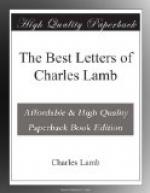Yours truly,
C. LAMB.
[1] The Quaker poet. Mr. Barton was a clerk in the bank of the Messrs. Alexander, of Woodbridge, in Suffolk. Encouraged by his literary success, he thought of throwing up his clerkship and trusting to his pen for a livelihood,—a design from which he was happily diverted by his friends.
LXXVI.
TO MISS HUTCHINSON.
April 25, 1823.
Dear Miss H.,—Mary has such an invincible reluctance to any epistolary exertion that I am sparing her a mortification by taking the pen from her. The plain truth is, she writes such a mean, detestable hand that she is ashamed of the formation of her letters. There is an essential poverty and abjectness in the frame of them. They look like begging letters. And then she is sure to omit a most substantial word in the second draught (for she never ventures an epistle without a foul copy first), which is obliged to be interlined,—which spoils the neatest epistle, you know. Her figures, 1, 2, 3, 4, etc., where she has occasion to express numerals, as in the date (25th April, 1823), are not figures, but figurantes; and the combined posse go staggering up and down shameless, as drunkards in the daytime. It is no better when she rules her paper. Her lines “are not less erring” than her words; a sort of unnatural parallel lines, that are perpetually threatening to meet,—which, you know, is quite contrary to Euclid. Her very blots are not bold, like this [here a large blot is inserted], but poor smears, half left in and half scratched out, with another smear left in their place. I like a clear letter; a bold, free hand and a fearless flourish. Then she has always to go through them (a second operation) to dot her i’s and cross her t’s. I don’t think she could make a corkscrew if she tried,—which has such a fine effect at the end or middle of an epistle, and fills up.
There is a corkscrew! One of the best I ever drew. [1] By the way, what incomparable whiskey that was of Monkhouse’s! But if I am to write a letter, let me begin, and not stand flourishing like a fencer at a fair.




